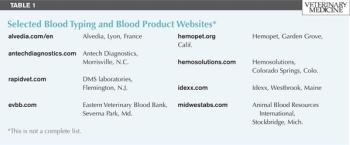
Seven blood types are recognized in dogs, and four blood types are identified in cats.
Department of Microbiology, Immunology and Pathology
College of Veterinary Medicine and Biomedical Sciences
Colorado State University
Fort Collins, CO 80523

Seven blood types are recognized in dogs, and four blood types are identified in cats.

The goals of this session are to provide some information related to blood types, blood typing, crossmatching, and to relate a few case examples that emphasize the usefulness of knowing what you may be working with.

Since the pre-analytical phase is by most accounts the most common source of errors related to laboratory testing, this session will focus on some of the more common causes and effects of these errors, and how to avoid them.

The manual PCV and plasma protein are quick, reliable methods for determining blood volume and hydration status when performed correctly. However, more than a bare-bones level of hematologic information has been made available with advances in technology.

The title of this presentation is apropos, considering the fact that there are over 9,000 species of birds and nearly 8,000 species of reptiles. Knowing how different the hematology is between dogs and cats exemplifies how different eagle hematology may be from a parrot, or an iguana from a snake.

QA, as it relates to the clinical laboratory, is an all encompassing program for the systematic monitoring and evaluation of the various aspects of producing laboratory results to ensure that standards of quality are being met.

This session will discuss basic methodologies used by selected common biochemistry analyzers and quality assurance issues which may result in better understanding of the advantages and disadvantages of various instrument types and ultimately assist with instrument selection.

Published: April 1st 2010 | Updated:

Published: April 1st 2010 | Updated:

Published: April 1st 2010 | Updated:

Published: April 1st 2010 | Updated:

Published: April 1st 2010 | Updated:

Published: April 1st 2010 | Updated: